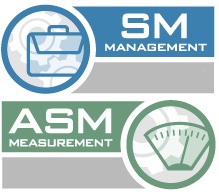SM/ASM 2001 - Software Management & Applications of Software Measurement

PRESENTATIONS
|
Launching a Web Development Team
Based on a real-life case study, learn how one Fortune 500 manufacturing company-with four development groups in two locations-created a flexible and cost-efficient Web development solution to meet the needs of an expanding business. Explore the development problems-and solutions-encountered on a project of this scope, including issues with geographically dispersed development. |
|
|
Managing Concurrent Software Releases in Development and Test
There is an ever-growing need to provide complex software products to customers on a short development schedule. Additionally, the customers need to be able to count on release dates for planning purposes. Instead of investing in an entirely new tool set that solves the configuration management issues associated with supporting concurrent development and support, existing tools can be used. This paper focuses on how to adapt and in some cases enhance an existing set of well-known tools to enable Lucent to excel in the market place. |
|
|
Managing Virtual Teams
Learn how to manage virtual teams such as those in dot-com companies, large corporations, and start-ups that may not be located in the same building, same town, or even the same continent. Explore the tips and techniques for getting the job done when you cannot necessarily meet face to face. Discover the danger signals that indicate your project is in trouble-and learn ways to get back on track when your project derails. |
|
|
Measures that Predict Change
Prediction becomes more accurate when there are measured trends to show the way. Knowing what to collect and review is only half of the process of predicting change. The rest of the methodology is understanding the data and being able to predict changes so that the project team can proactively respond to change events. Learn how organizations within EDS have begun to accurately predict changes. |
|
|
Metrics: Giving the Answer to the Right Question
What metrics are you going to give me? This is the type of question managers ask their QA analysts at the start of each project. In this presentation, learn how to interpret data to create a metric that can answer a specific question asked by management. Explore how quality assurance and testing-from goal setting to implementing tactics-can assist in creating reliable metrics. Kenneth Paczas looks at many of the questions that have been asked by management--and the metrics that were used to answer them. |
|
|
Organization: The Forgotten Dimension
Explore the software project manager's actual, perceived, and desired position in an organization. Learn how the differences in these three views-coupled with the understanding of roles, responsibility, authority, and accountability-may be more important to a manager's success than the method used to manage the project. Discover techniques that leverage "difficult" organizational structures and cultures to enable the free flow of information that is critical to process improvement and project performance. |
|
|
Predicting Software Errors and Defects
This paper introduces a fault model that predicts the number of errors and defects throughout the development cycle. Project managers can use this information to quantitatively determine if the development process is in control, may be going out of control, or is clearly out of control. This model is able to adjust estimates based on the most current data available. |
|
|
Predictive Metrics to Estimate Post Project Costs
How much will it cost to support your software project based on current estimations? Discover the answer to this question by using statistical estimation methods-including the S-curve and the Rayleigh curve-to help you determine where your projects are in relation to required quality and trendings to meet your post-project cost goals. Learn how to use metrics to predict post-project costs and make better release decisions based on these predictions. |
|
|
Process Improvement in Large Organizations: Walking the Maze
Every problem-solving activity in an organization requires some learning. Both the stakeholders and the |
|
|
Program Management vs. Project Management
When a company has multiple products that are related in some way, management may choose to group those projects together under a Program Manager. Although Program Management areas are similar to Project Management areas (i.e., scope, time, cost, quality, communication, and risk management), there is a distinct difference between the tasks performed. Learn the differences between these two areas. Explore the keys to become a successful Program Manager. |
|


